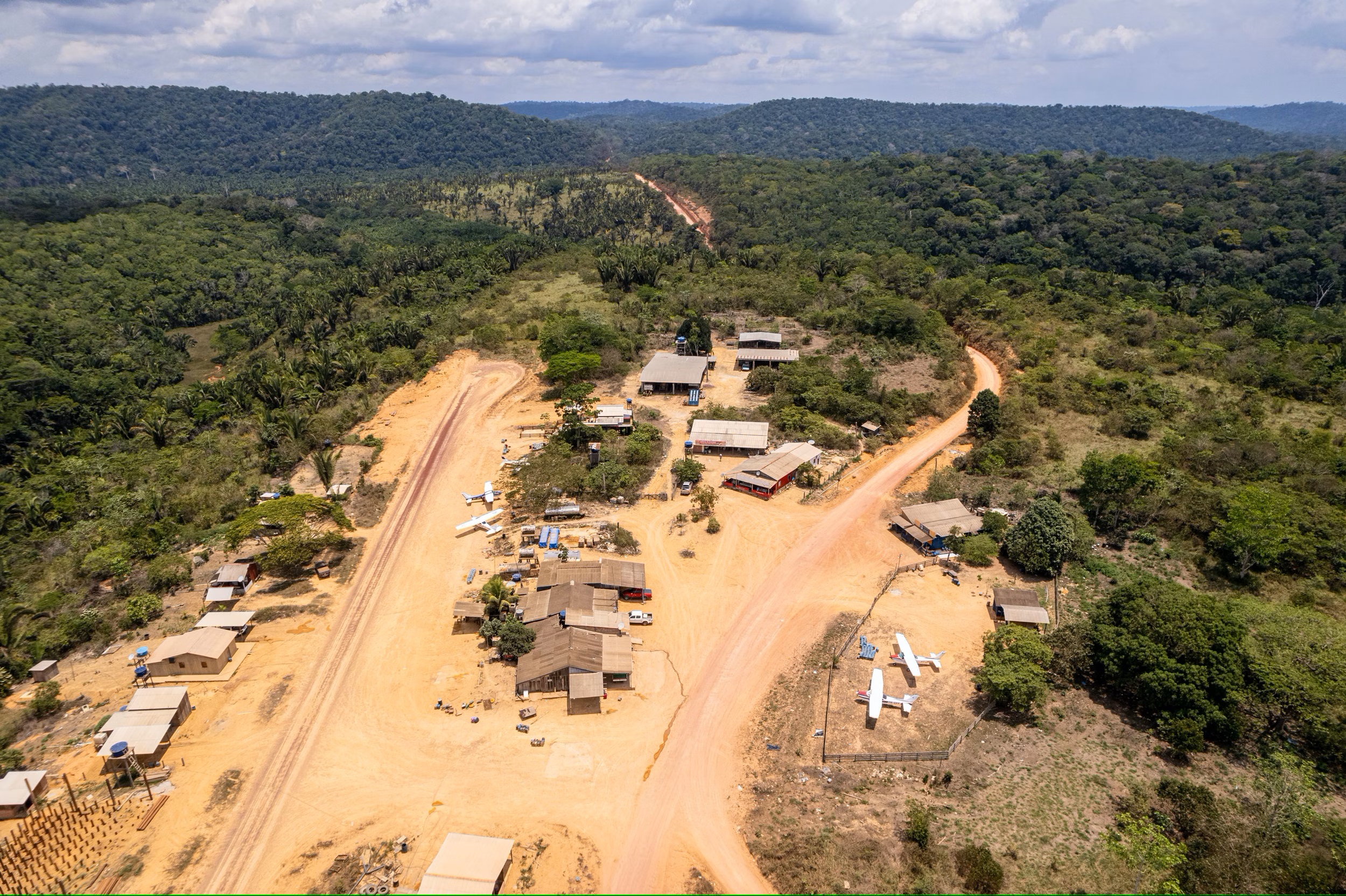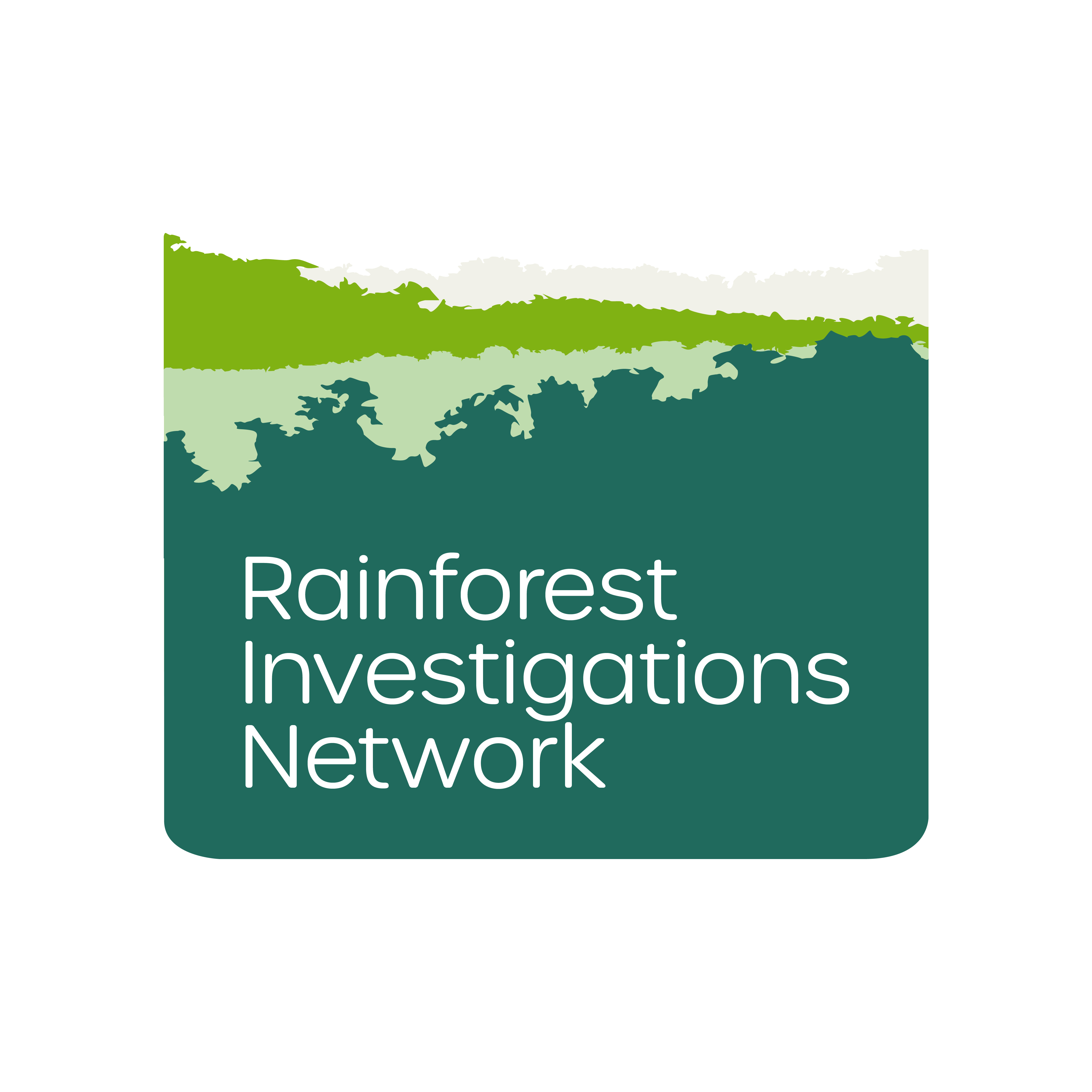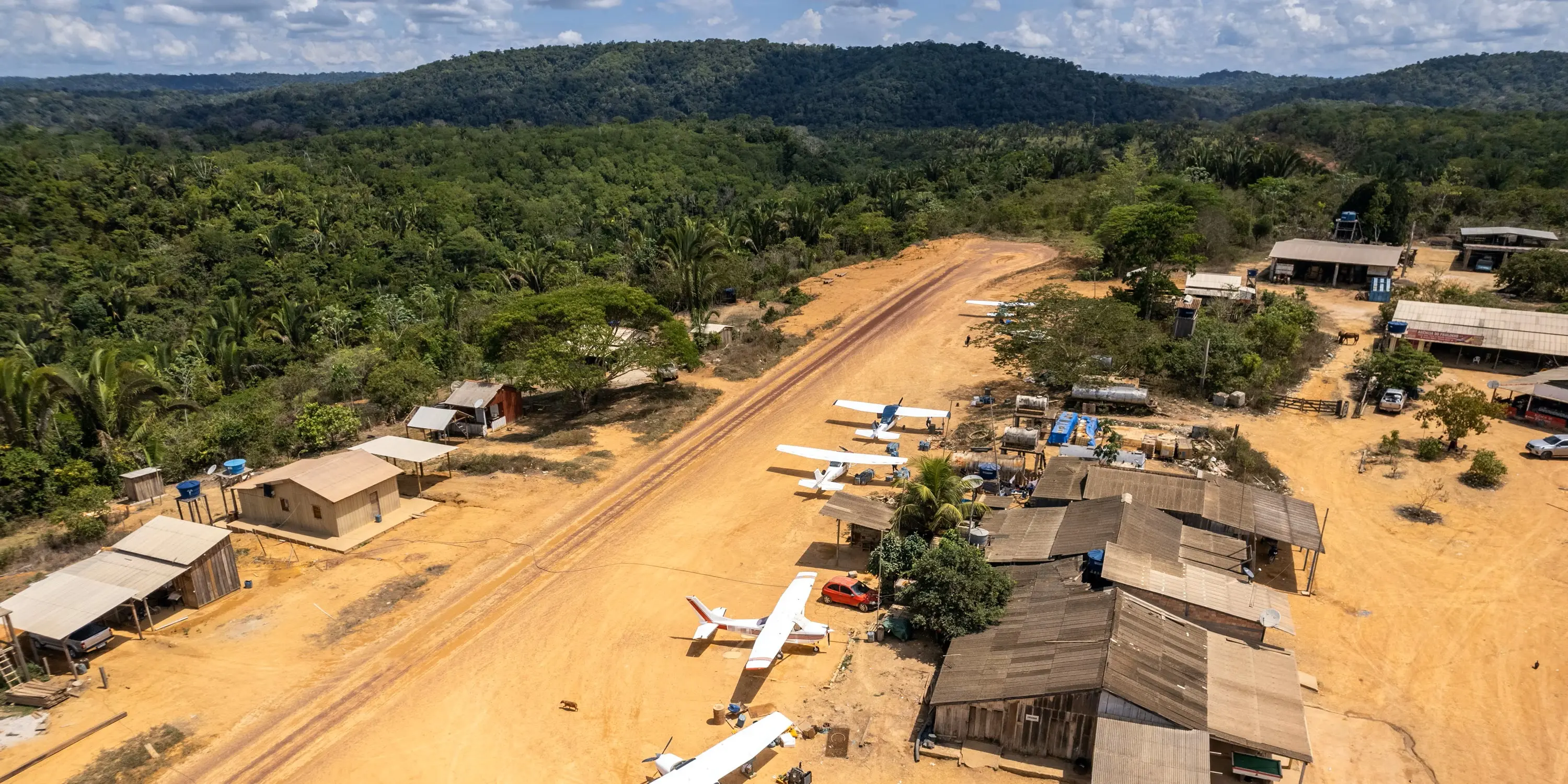
To view this report's interactive elements, click here.
A small brown scratch that tears through the green of the forest.
This is what an airstrip built in the middle of the forest looks like when viewed from satellite images. Down there, on the Amazon floor, are small roads sometimes a mere 300 meters long and about 20 meters wide, just big enough for small aircraft to land and take off.
These planes, which land loaded with fuel and supplies, are key to understanding how "garimpos," or mines the size of dozens of soccer fields, appear within a few months in the middle of the largest rainforest on the planet. These mines are at the beginning of a supply chain that ends in large international gold markets, with global technology companies as part of the clientele.

Whistleblowers and others in possession of sensitive information of public concern can now securely and confidentially share tips, documents, and data with the Pulitzer Center’s Rainforest Investigations Network (RIN), its editors, and journalists.
In Amazônia Legal, there are 362 runways that are clandestine—without registration at the National Aviation Agency (Anac)—and around which there are trails of deforestation for gold mining. The number more than triples if we consider all the runways opened without authorization and registration in the region, of which there are 1,269. This number exceeds the total number of runways registered in the region, which reached 1,260 in April this year. This data was consolidated on May 1st.
This unprecedented survey of clandestine runways in the Amazon is the result of a collaboration between the Intercept, the Pulitzer Center, and the American non-governmental organization Earthrise Media, which gathered the data from satellite images of Amazônia Legal collected in 2021.
The number we arrived at also includes tracks found on the OpenStreetMap platform, shared by the NGO Instituto Socioambiental and mentioned in police investigations, as well as structures identified with the naked eye throughout the research. We included in the total number all the tracks that showed visual indications that they were used in 2021 and 2022. The data was analyzed by the Intercept in partnership with reporters from The New York Times, a partner in this publication.
The demand for air transport from mining in the Amazon is directly related to the difficulty of access to the places where the "barrancos," as the small-scale mines are called on the ground, are located. A trip by road or boat, which can take days or weeks, only takes minutes or a couple of hours by small aircraft.
Where there's gold, there's an airstrip
Itaituba, Jacareacanga, and Novo Progresso, the three municipalities in Pará State that have the highest concentration of mining license, which are often used for “heating” gold, namely registering illegal gold as if it was extracted from an authorized mine, also have the highest amount of clandestine airstrips related to deforestation for mining.
Cross-referencing the geographic coordinates of the tracks with mining deforestation alerts from Amazon Mining Watch, a data platform created by the Rainforest Investigations Network and Earthrise Media, shows that, of the 234 tracks in these three locations, 224 have mining deforestation trails within a 20-kilometer radius. Or no less than 95.7 percent of the total.
It is no coincidence that the region leads the ranking in destruction of native forest areas by gold mining in Brazil. According to a survey by Mapbiomas, in 2020, Itaituba and Jacareacanga were the national leaders in deforestation by miners, with 54,340 hectares taken by gold mining, an area larger than that of Maceió, the capital of the state of Alagoas. Only 36 hectares of this area are industrial mines. Considering just the figures for gold mining, the two cities in Pará account for more than 50 percent of the area deforested in the whole country for this purpose.
In 2021, the National Mining Agency (ANM), responsible for regulating and disciplining the exploitation of mineral deposits in Brazil, received a declaration of 4.6 billion Brazilian Real in gold extracted in Itaituba, Jacareacanga and Novo Progresso—17 percent of all the gold declared in the country that year. However, as research by the Federal University of Minas Gerais and inquiries by the Federal Police have already indicated, not all of this gold came from legal mines. To keep this billion-dollar business running, unregistered tracks are widely used.
Anthropologist Luísa Molina researches the effects of illegal mining activities on the Indigenous Peoples of Médio Tapajós, in the southwest of Pará. She explained to me how the illegal gold producers exercise their power in the region. She demands action from the control bodies.
"It's not humble workers who use these tracks, it's big businessmen,” she said. “If the government wants to really fight the illegal gold business, it has to supervise the logistic chain by land, river and air. Also because these logistics do not only serve the illegal gold economy, but also drug and weapons trafficking.”
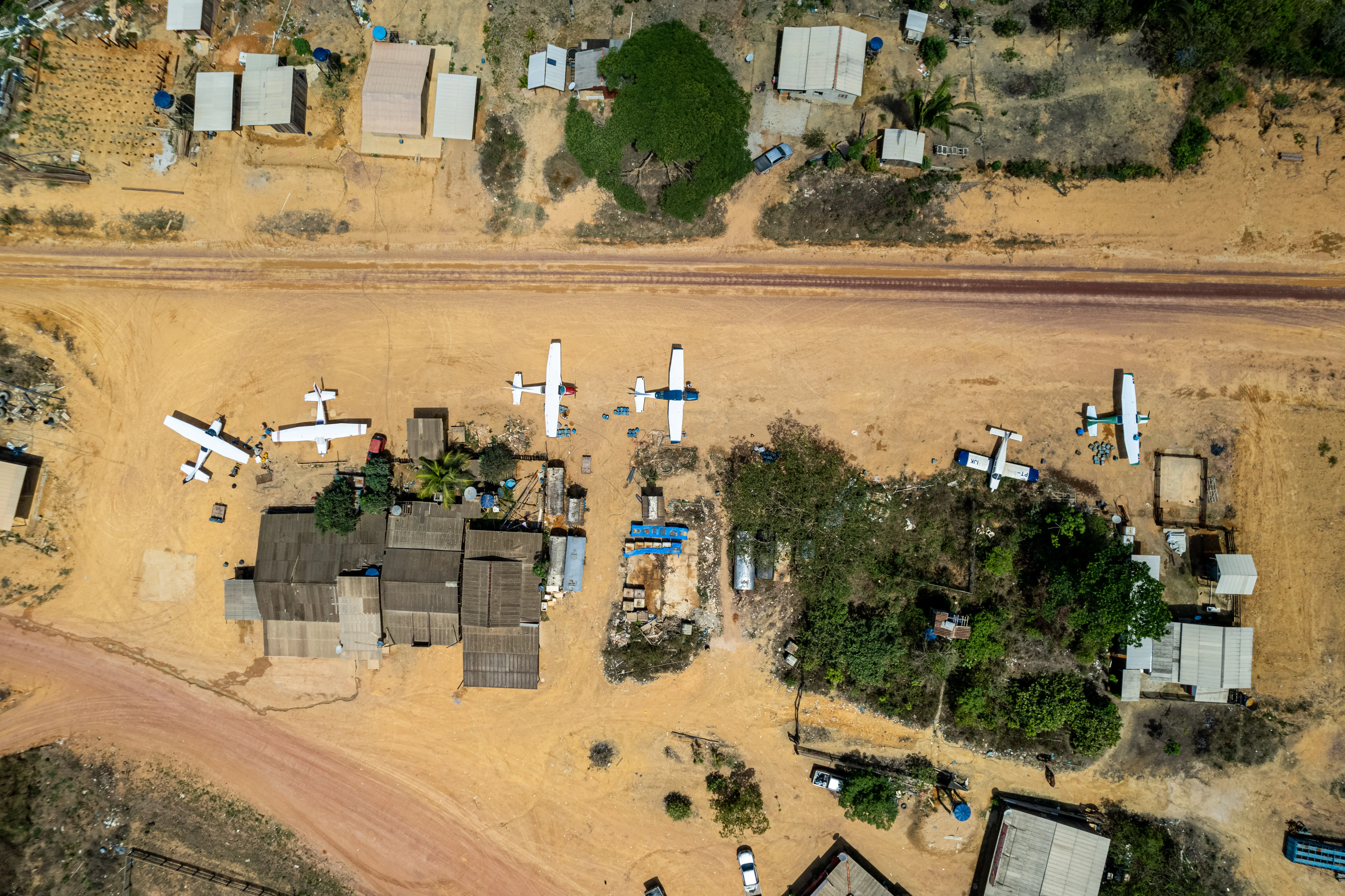
Anac speeds up runway permissions
The National Civil Aviation Agency (Anac) does not seem willing to inspect irregular runways. Until December 2021, the Brazilian Aeronautical Code required that the construction of airfields demanded prior authorization from the agency, the lack of which can be penalized with a fine—but the agency did little to enforce the law. According to an answer I received in July last year, after making a request based on the Access to Information Law, Anac only issued six fines for building irregular runways throughout the country between 2016 and 2021, none of them in Amazônia Legal.
In a note sent in early July, Anac informed me that they received 49 complaints about clandestine runways, aircraft operators and pilots in the Amazônia Legal area between 2018 and 2021, and nine more in the first six months of 2022. According to the agency, all these cases were investigated. However, considering the answer about fines applied that I received via the Access to Information request, none of the 49 cases from 2018 to 2021 resulted in punishment. When questioned about this data, Anac changed its statement. The accusations were not only about clandestine runways, but also about aircraft and pilots who operated irregular flights.
The provisional measure 1.089/2021 of the Bolsonaro government has made the lives of owners of clandestine airstrips even easier. Since December 29, Anac has been relieved of the burden it didn't seem willing to carry. The article that required prior authorization from the agency for the construction of runways was revoked in the MP. The measure became law with the approval of Congress, in May, and the presidential sanction in the following month.
I asked Anac about the changes, and the regulatory agency replied that "the prior authorization for construction of aerodromes for public and private use remain in force, in accordance with Resolution No. 158 of July 13, 2010, which requires prior authorization for the construction of aerodromes and their registration with ANAC. However, in the same note, the agency shows how the legislation has become more fragile: "Eventual regulatory adjustment resulting from the absence of legal requirement will be studied and will go through all the appropriate normative rituals.”
The change in the legislation did not affect the requirement that flights must be regulated by the Aeronautical Authority. But even in this the government has found a way out. The government indefinitely removed the restrictions on landing on and takeoff from routes without registration with Anac, a gift for those who use clandestine runways in Amazônia Legal. The change had been applied in July last year, because of the COVID-19 pandemic, to facilitate health care for indigenous and riverside communities located in remote regions. Now, it has become definitive.
For the Bolsonaro government, an early ally of illegal mining, free access to clandestine tracks in the Amazon promotes "regional development, social integration, humanitarian care, access to health care, and support for security operations," which "must be maintained regardless of their exceptional nature."
But the reality is quite different. Along the stretch of BR-230, the Transamazônica Highway, between Itaituba and Jacareacanga, it is possible to see at least five active landing and takeoff runways for small planes used for years by mining pilots. Three of them were registered by Anac last year, after decades of being part of the clandestine economy.
The oldest is known as the runway 180, in reference to the mileage of the highway. The runway was approved by Anac in August 2021 but it has been in operation since the 1980s and, to this day, serves as a stopover for flights to more distant locations for dozens of gold mining pilots. There are even guesthouses next to it.
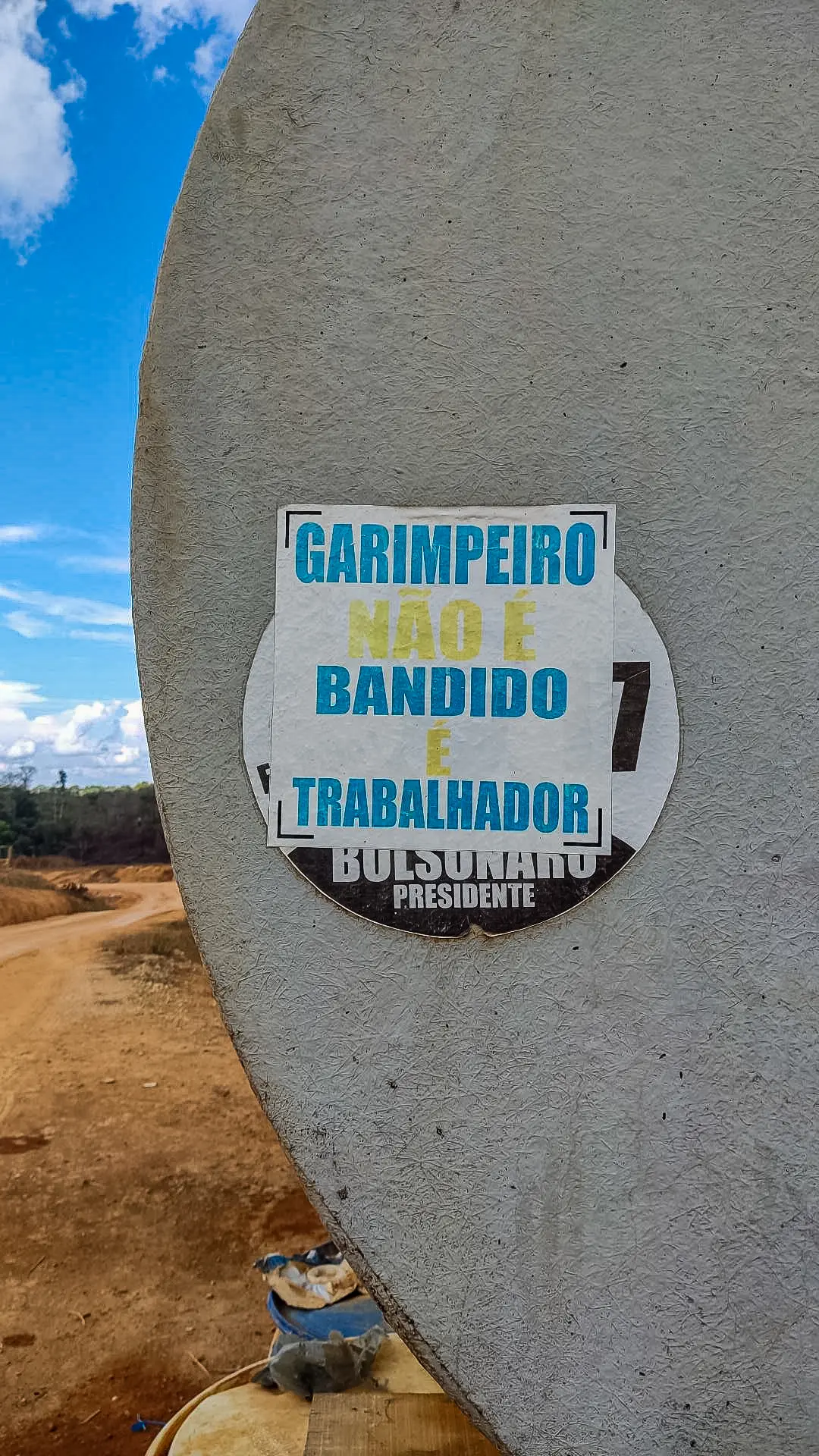
Last October, when I was there to interview pilots for the Intercept's mini-documentary Pilots of the Amazon , I saw at least 20 landings and takeoffs in just one day, equivalent to the movement of the airport of Maringá, in Paraná, a city with 436,000 inhabitants, a very high Human Development Index, and the 50th largest municipal GDP in Brazil.
Runways such as the 180 are among the 213 registered by Anac in Amazônia Legal in 2021, the highest number of permissions in the last decade. This is three times the total number of new runways permitted by Anac in 2018, the last year of the Temer administration, when 66 structures were registered.
The Bolsonaro government needed only four months to surpass this number. Between January and April 2022, Anac authorized 76 runways in Amazônia Legal. One of the companies that had the agency's blessings was Gana Gold, which, after two years using a clandestine runway, managed to regularize it in January without having to pay any fines to Anac. The runway serves to support a mine that was embargoed by the Brazilian Institute for the Environment and Renewable Natural Resources, Ibama, and the Chico Mendes Institute for Biodiversity Conservation, ICMBio, in decisions from the Federal Court of Pará.
The public prosecutor from the Federal Public Ministry in Santarem, Gustavo Alcântara, points out that the runways used by the Special Indigenous Health Secretariat, Sesai, are still not registered with Anac. Meanwhile, runways near places of illegal extraction have been authorized by the agency.
"There is an administrative problem in the federal government, because there doesn't seem to be an evaluation criterion about the function that the runway is going to have before it is approved by Anac," Alcântara said.
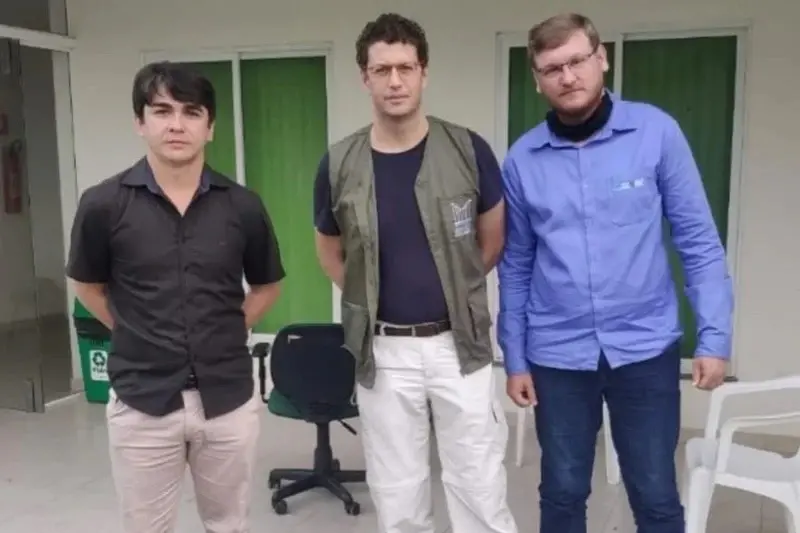
Mining companies, politicians, and lobbyists
Cross-referencing the locations of the 1,269 clandestine tracks with public data from Deter, the deforestation warning system of the National Institute for Space Research (INPE), shows that 72 percent of the areas deforested by mining are in places where there is not even a requirement for gold mining. In other words, it is illegal mining, an environmental crime under article 55 of Law 9.605/1998. Even in the other 28 percent where mining would have a chance of being authorized, in half of the cases there are irregularities, with deforestation outside the period authorized by ANM.
We consider in this survey the existence of deforestation within a radius of 20 kilometers counted from the center of the runways. Of the 362 that fit this parameter, one of the most serious cases is the destruction of 10,541 hectares, the equivalent of more than 14,000 soccer fields put together. Part of the area is the object of mining application number 850240/2003, made in the name of André dos Santos. He even obtained a research authorization in the area between September 2015 and September 2018. But Deter registered deforestation alerts in the region in March 2021.
Besides this one, there are six other mining processes in the name of Santos in the 20-kilometer perimeter around the runway. All have or already had permission from the ANM for exploration, but it is possible to verify by satellite images that deforestation occurred before or after the authorized period.
Considering all the mining processes for gold on behalf of Santos in Itaituba, a municipality in southwest Pará that leads the production of the metal through mining activity in Brazil, the number of applications rises to 16. On the ANM site, the miner filed a document informing as his telephone numbers and e-mail address the data of a mining lobbyist, forest engineer Guilherme Aggens.
With free transit in Brasilia, lobbyists worked for the licensing of Gana Gold, which extracted R$1.1 billion in gold from an irregular mine in Pará.
By phone, Aggens told me that he represents André dos Santos in administrative measures at the ANM, and that this is why his cell phone was indicated by Santos. Aggens also said that he has "no knowledge" about the runway.
With free transit in Brasilia, Aggens acted directly in the irregular licensing of the company Gana Gold, which extracted 1.1 billion Brazilian Real in gold from an irregular mine installed in the Tapajós Environmental Protection Area, a federal conservation unit located between the municipalities of Itaituba, Jacareacanga and Trairão.
The Intercept revealed the case exclusively in September of last year. A few days later, ICMBio embargoed the mine. In late March, I reported again on Gana Gold, this time showing the political pressure exerted by high-ranking positions in the Bolsonaro government, in Brasilia, to release the mining company from the environmental embargoes it had been subject to. I also showed how the company was not complying with the environmental sanctions imposed in September. In July, a new Federal Police operation carried out warrants against Gana Gold, which had its activities suspended and 1.1 billion Brazilian Real in assets blocked, in addition to the arrest of its owners.
In the Tapajós region, at least 105 clandestine runways are located not only near areas with mining processes to research or commercially exploit gold reserves, but within areas required for mining. But while this is an important indication, it is not enough to prove that the owners of the ANM processes operate landings and takeoffs from these runways.
An owner of two aircraft, João Ivan Bezerra de Almeida has five applications in Itaituba to mine in areas that already have airstrips. A businessman in the civil construction industry, Almeida was a candidate in the last two municipal elections in Itaituba for PSDB and PL, respectively—he wanted to be mayor. He lost, but was always accompanied by businessmen from the gold sector.
In 2016, Almeida received a donation of 130,000 Brazilian Real for his campaign from Dirceu Frederico Sobrinho—30 percent of the total declared by the candidate to the Electoral Justice. In 2020, Almeida's vice-mayoral candidate was Roselito Soares da Silva Filho, son of former mayor Roselito Soares. Father and son are partners in companies linked to Ourominas Distribuidora de Títulos e Valores Mobiliários, Ourominas DTVM.
Even well-known mining companies sign mining applications in areas already devastated for the opening of clandestine tracks. Since 1993, the Canadian giant Belo Sun has owned a mining claim in the APA Tapajós. In this region lies the mining community Patrocínio, which opened back in the 1960s. Belo Sun's mining process was authorized to mine by ANM between 2007 and 2014, but this did not prevent the mining activity from continuing to increase in the following years, alongside an 800-meter-long runway track.
Belo Sun's mining application at the ANM records, filed in October 2020, included a request for total assignment of rights, i.e. the surrender of the concession it had obtained to another person or company. Still, the process remains under the responsibility of the Canadian group, whose main project in Brazil is the exploration of a gold mine between Altamira and Senador José Porfírio, in Pará.
Belo Sun is one of six mining companies that are signatories to an agreement with the Pará state government stating the gold it extracts should benefit a newly built refinery in Belém, the state capital. The Intercept showed in February that one of the main investors in the refinery is a Belgian businessman convicted of fraud and money laundering in his country—in gold deals. In the month following the publication of the story, two companies linked to the Belgian businessman received sanctions from the U.S. Treasury Department.
Another signatory to the agreement with the Belém refinery that also claims to mine in areas with unregistered tracks is the Brazauro mining company, which since 2010 has belonged to Canadian groups. In the Tapajós region, eight clandestine tracks are located on land delimited in the company's mining requirements.
I have sent questions to the two mining companies about the clandestine tracks situated in mining claim belonging to them, but neither has responded as of the publication of this report.
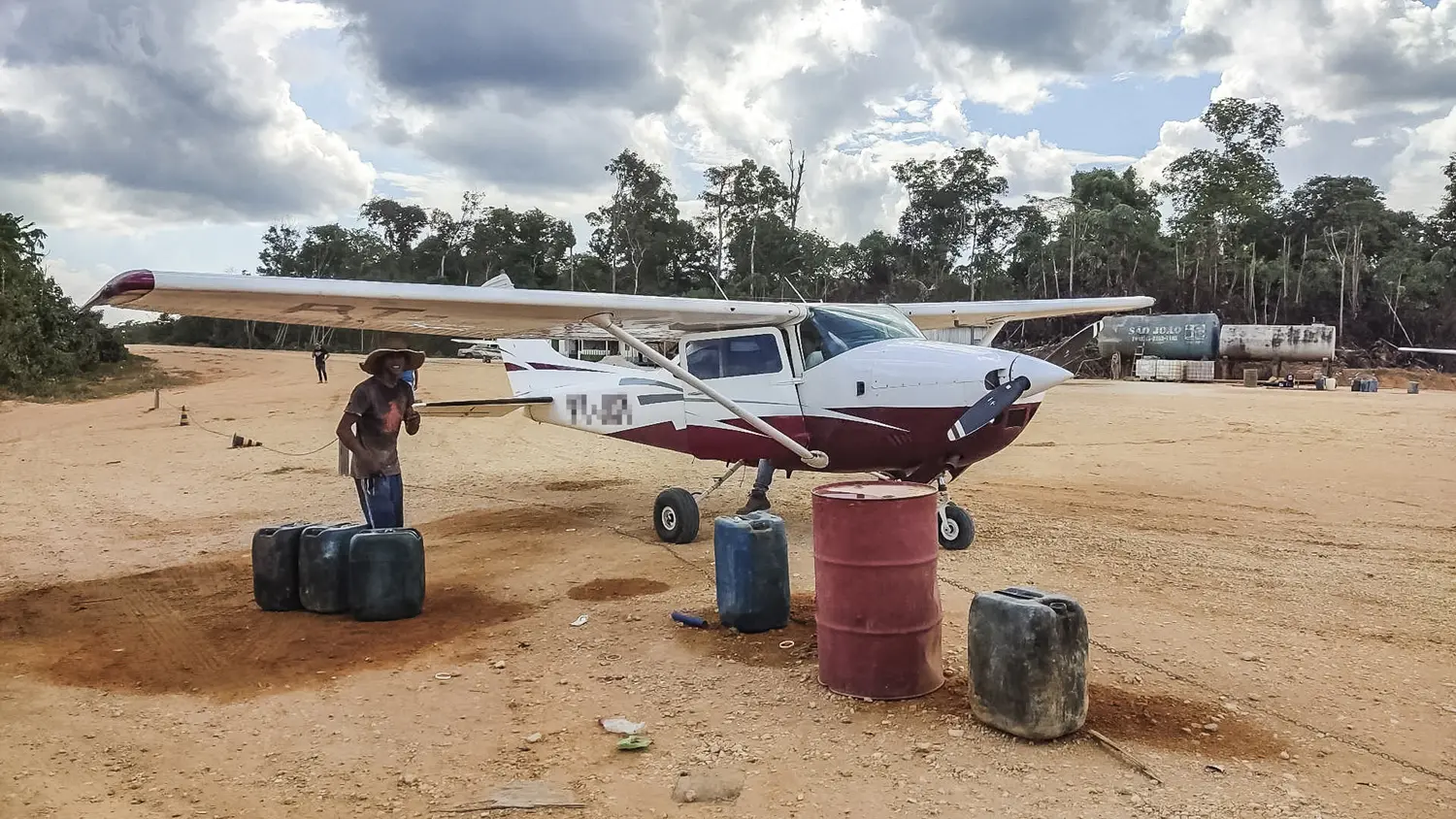
From prospector to aviation entrepreneur
Piquiatuba Táxi Aéreo is one of the regional aviation companies with the highest volume of payments in contracts with the federal government for transportation in Amazônia Legal. The founder, Armando Amâncio da Silva, who died in October 2020, started his business as a gold prospector in the late 1980s. From then on, he has built one of the largest air taxi companies in the country.
Brazil’s Transparency Portal reports that since 2014, Piquiatuba has billed more than 143 million Brazilian Real in contracts with the federal government. The largest portion of this amount, 107 million Brazilian Real, is the result of payments made by the Bolsonaro administration. The services provided by the company range from transporting health teams to serve Indigenous communities to logistical support for the Armed Forces.
But the federal government is not Piquiatuba's only customer. The company also used its aircraft to provide logistical support to one of Amancio's illegal mines in Almeirim, in northern Pará. The “barranco”, known as “garimpo do Limão” (Limão mining site) is in a restricted protected area, the Maicuru Biological Reserve, and only 10 kilometers away from one of the borders of the indigenous territory of Rio Paru d'Este. The information comes from an investigation by the Federal Police, which was launched in October 2020, a few days before the death of Piquiatuba's owner. In the operation, the police seized from Amancio's house almost 45 kilos of gold with no proven origin.
"Besides being unaccompanied by documentation of origin, the modus operandi of the defendant Armando Amâncio da Silva and the fact that he is responsible for the illegal extraction of gold in Garimpo do Limão corroborate the illegal nature of the gold seized at the defendant's residence," states the Federal Public Prosecutor's Office, MPF, in a public civil action filed last year.
For federal employees working in control bodies and agencies for the protection of indigenous lands and the environment, the suspicion that companies contracted by the government also provide services to criminals creates uneasiness and mistrust in more sensitive operations.
"Piquiatuba is the company contracted to carry out Funai and indigenous health flights in certain regions of Pará, but we know that it also flies in the service of miners. If we need to fly over them to identify illegal mining on indigenous land, we prefer not to call Piquiatuba and try to hitch a ride on the aircraft of other institutions, because we know that there is a conflict of interest involved," explained a member of the staff of the National Indian Foundation. He preferred not to have his name revealed to avoid reprisals from the government.
The Federal Police investigated the planes that landed on a runway near the so-called Limão mining site between 2015 and 2018. "At least 182 flights" to the illegal mine were operated by Piquiatuba, the officers said.
'Piquiatuba Táxi Aéreo works as a fundamental instrument of criminal activity, providing support to the mining.'
Two months after the operation, the Federal Court responded to a request from the MPF and provisionally blocked 268 million Brazilian Real from the estate of Piquiatuba and its founder, to guarantee compensation for the environmental damage caused by the illegal mining scheme. More than one hundred kilos of gold were removed from the illegal mine, according to the investigation.
In February last year, Gustavo Alcântara, the public prosecutor for the MPF, filed a public civil action in which he asks that Piquiatuba and Amancio be sentenced to pay almost 400 million Brazilian Real for illegal gold sales, environmental damage from illegal extraction, and collective damage to the indigenous people of the Paru D'Este land. In the lawsuit, the prosecutor explains how the air cab company that earns millions from the federal government also provided services to the miners.
"Armando Amâncio da Silva made his airline, Piquiatuba Táxi Aéreo, function as a fundamental apparatus of the criminal activity, with high activity of the company's airplanes to the landing strip supporting the Limão garimpo having been recorded," Alcântara wrote in the indictment.
I talked to prosecutor Alcântara by phone, and he pointed out a problem in combating illegal activities that use aircraft in the Amazon: The equipment often remains with the owners even after operations by control agencies.
"There is jurisprudence of the Superior Court of Justice on the forfeiture of any asset that is used for environmental crime. Aircraft that are seized in a situation that constitutes an environmental crime, such as illegal mining, should be taken immediately from the owner. But this doesn't always happen," he said.
The defense of Amancio and Piquiatuba Táxi Aéreo is a well-known Brasilia law firm called Catta Preta Advogados. Lawyer Paulo Emílio Catta Preta de Godoy has among his clients Fabrício Queiroz, former advisor to Senator Flávio Bolsonaro involved in the corruption case known as “rachadinhas.” He also legally represented the militiaman Adriano da Nóbrega, who died in 2020, one of the suspects for having participated in the assassination of councilwoman Marielle Franco and Anderson Gomes in March 2018.
Catta Pretta replied to me that all of Amancio's gold was "regularly extracted from areas with the necessary PLGs [Small-Scale mining permissions]." He also said that Piquiatuba Táxi Aéreo has no relation to gold deals with DTVMs, and that the judicial block on the accounts of Piquiatuba and Amâncio's estate has been reduced to 13 million Brazilian Real.
About the 182 flights by Piquiatuba aircraft for the operation of illegal mines, the lawyer said that the company does not exercise or contribute to any activity related to mining. In January 2021, still during the investigation, the defense of Amancio and Piquiatuba even manifested in court informing that the trips identified by PF would be to "unapproved tracks located in indigenous villages, in the execution of public transport contracts in the interest of indigenous health."
Brazilian aviation rules do not allow flight plans for unapproved runways. Although the Limão mining area was illegal, the runway near the “barranco” had active approval by Anac between 2011 and 2018, so it could receive official flights. According to the defense, the company indicated this runway in the flight plans, but the trips would be to the runways without homologation in indigenous lands in the region. However, in the MPF's charge, prosecutor Alcântara explained that the defense of Piquiatuba would be "manifestly unfounded," because the contract for service in Indigenous lands in the region was only signed in August 2018, after the period analyzed by the Federal Police.
Where there is a runway, there is more mining
The chief of the criminal forensics unit of the Federal Police in western Pará since 2015, Gustavo Geiser participated in investigations into the Limão mining site and several other cases related to illegal gold mining in the Tapajós region. According to Geiser, a landing strip is one of the main indications of the size of the operations of a mining site.
"Whenever you imagine an operation in a place like the Amazon rainforest, you have to think about the logistics of the activity. Building and maintaining a runway is expensive, so there are only runways in places where [gold] extraction is big," explained the expert.
In the lawsuit filed in court, the MPF claims that the gold extracted in Limão was declared to the ANM as coming from legal mines in Itaituba and Almeirim. To do this, the former miner-turned-aviation entrepreneur Amancio had the collaboration of the Distribuidora de Títulos e Valores Mobiliários Ourominas. The company is the target of previous complaints by the MPF about gold panning and even had 72 million Brazilian Real blocked by the Federal Court of Pará in 2018.
In the scheme, the ore extracted in illegal mining is taken to a securities distributor like Ourominas, which declares in a hand-written invoice that it has bought the precious metal from owners of valid mining permit processes with the ANM.
Incredibly, this handwritten purchase declaration is all that is required by the Internal Revenue Service of Brazil (Receita Federal), whose regulations on the subject are more than 20 years old. The information is contained in a report produced by the 4th Coordination and Review Chamber of the Environment and Cultural Heritage of the Attorney General's Office, which assists MPF prosecutors in environmental cases.
Published in 2020, the report mentions that the norm requires as fiscal documents of the gold chain only pen-filled paper or "carbon paper." The MPF criticizes the weakness in control at this early stage of the gold trade and relates this to the "incidence of tax evasion and money laundering in the sector.”
In the investigations into the Limão mining operation, the Federal Police identified at least five legalized mining processes in Itaituba and Almeirim in negotiations between Amancio and Ourominas. Satellite images showed no sign of exploitation in the areas of the mining processes reported as the origin of the gold negotiated. In other words: The gold came from somewhere else.
The choice for untouched mines in Itaituba and Almeirim to “heat up” (hide the true origins of) gold seems not to have been random. Between 2019 and 2020, Itaituba, Jacareacanga and Novo Progresso concentrated 85.7 percent of the mining processes nationwide used for pirate gold trading with indication of origin in areas that are untouched, with native forest, as pointed out in the study Legality of gold production in Brazil, done by researchers of the Federal University of Minas Gerais (UFMG).
According to the survey, more than a quarter of the 174 tons of gold produced by Brazil in 2019 and 2020 has evidence of illegal origin, generating a possible environmental damage of 31.4 billion Brazilian Real for the country. This document was used by the MPF to file billion-dollar lawsuits against the three main securities distributors that operate in the region: Ourominas, FD'Gold and Carol DTVM.
In the lawsuits, the prosecutors ask for convictions totaling 10.6 billion Brazilian Real and indicate that the three companies traded 4.3 tons of gold with false origins in the two years analyzed by the investigators.
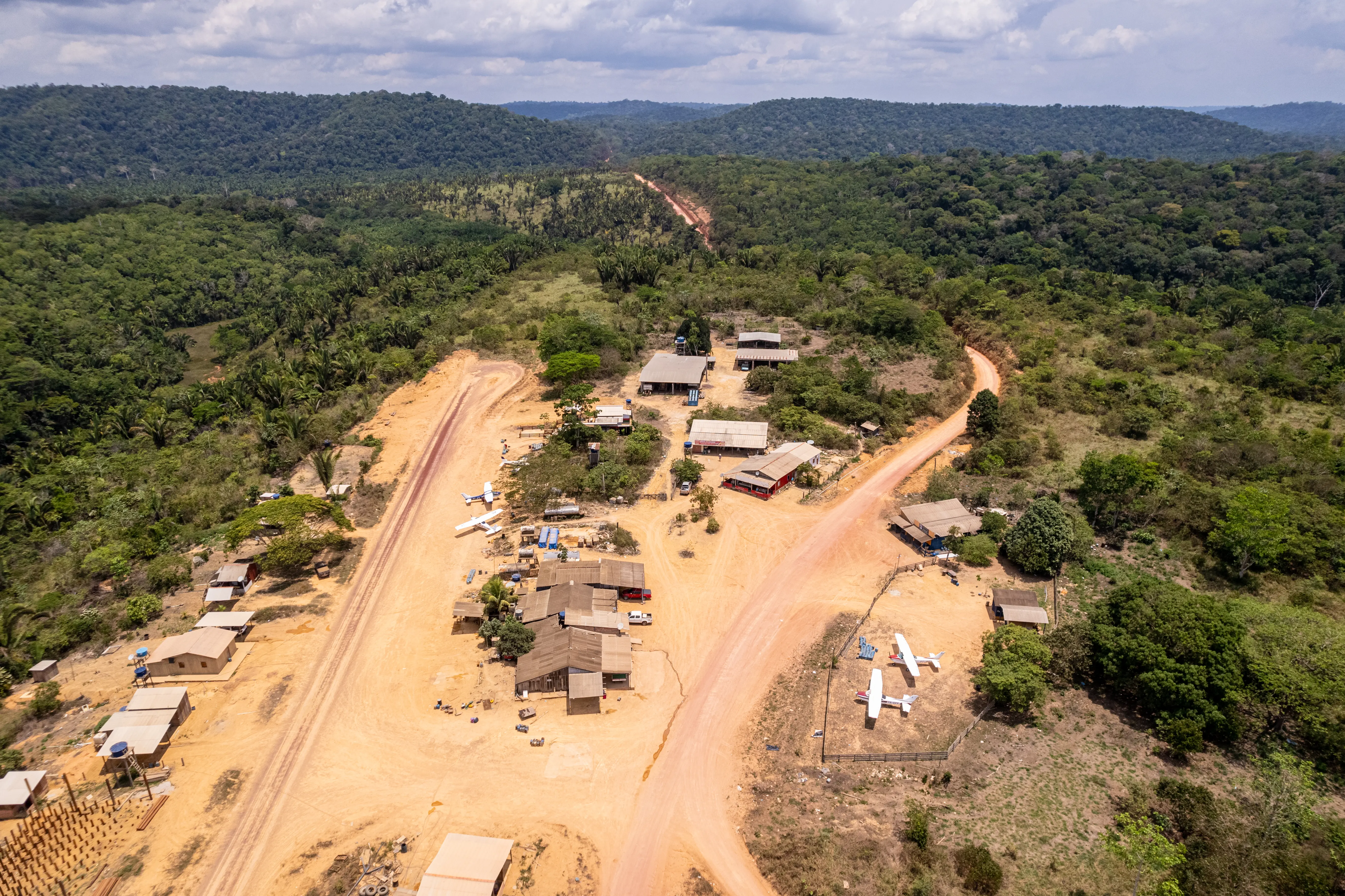
From mining to Silicon Valley
For the “heating up” of gold to work, the owners of the legalized front mines have to cooperate. What the Federal Police found in many cases were private contracts between them and the securities dealers.
In comparing information from the Limão mining site survey and recent data from UFMG's research on untouched PLGs, I found at least two shell mine owners who reported selling to Ourominas between 2015 and 2018, the period when the company bought illegal gold from Armando Amâncio da Silva, and who appear as sellers to FD'Gold in the following two years.
During investigations into the Limão mines, the Federal Police seized more than 3,000 invoices for gold purchases made by Ourominas between 2015 and 2018. Mining applications in the name of Edilene Bezerra Feitosa and José Antunes appear on 734 invoices for Ourominas. They total almost 11 million Brazilian Real in business, according to the PF investigation.
One of the PLGs in Feitosa's name, number 851197/2013, was never exploited, but has already yielded 3.2 million Brazilian Real for Ourominas between 2017 and 2018. In the two following years, the same Feitosa mining process yielded 8.4 million Real for FD'Gold. The data for 2019 and 2020 are from UFMG's research and from the complaint filed by the MPF of Pará last year. I was unable to locate Feitosa and Antunes. There is no phone number or email address in their mining process documents at ANM.
In response to questions that I forwarded about the case of Limão mining site, Ourominas DTVM wrote that it will not comment because "it does not figure in the passive pole (as defendant) in the police operations cited." But it is not quite like that. A purchase post from Ourominas' gold company is cited in the Limão investigations, and the same gold purchase and sale invoices served as the basis for a public civil action by the MPF against Ourominas DTVM, in May 2019.
The three record-breaking companies buying gold with false origin are members of the National Gold Association, Anoro. The president of Anoro and founding partner of FD'Gold is Dirceu Frederico Sobrinho, the supporter of political campaigns in Itaituba and a well-known figure in the mining industry who owns or is legally responsible for three gold mining requirements overlapping with two clandestine tracks in our survey.
In early May, the Federal Police seized 78kg of gold in Sorocaba, in the interior of São Paulo, with suspected illegal origin. The cargo, valued at 23 million Brazilian Real, was transported in a small plane and was under escort by military police from São Paulo. Two days later, Sobrinho declared that the gold belonged to his company, FD'Gold, but denied that the cargo was illegal.
Sobrinho has a way in with the Bolsonaro government, and his connection with powerful politicians does not stop there. In 2018, he tried to be the substitute of Senator and re-election candidate Flexa Ribeiro, from the PSDB of Pará. Ribeiro did not get elected, but he was not helpless. He currently holds a consulting position at Anoro. For the now mining specialist, Ibama has to "educate" miners on illegal extraction sites, not just fine them.
Sobrinho also has a partnership in a mining company, Ouro Roxo, and had a direct stake in Marsam Refinadora de Metais until 2019. The company currently has his daughter, Sarah Frederico Westphal, on its board.
Marsam Refinadora was founded in 1997, but another company named Marsam Metais S/A, trading and exporting ore, had been established in 1966. In the early 2000s, José Inácio Cortellazzi Franco and Roberto José Steinfeld, the first directors of the ore export company, were convicted for their involvement in the case of the Fernando Henrique Cardoso government bailout of banks during the 1999 currency crisis.
Steinfeld, former director of FonteCindam bank, was sentenced by the Federal Court of Audit to return almost 5 billion Brazilian Real to the public coffers along with other people. Franco, then director of FonteCindam bank, was convicted of crimes against the financial system in the second instance of the Federal Court. The Special Department of Federal Revenue of Brazil reports that Marsam Metais closed its doors in 2018, but Franco is currently Sobrinho's partner in Ouro Roxo.
It is through refiners like Marsam that gold of dubious origin reaches global technology companies.
Through the gold trading companies Reserva Metais and BP Trading, both linked to Sobrinho and his companies, Marsam Refinadora has been providing services to the Brazilian mint for at least six years, including refining some of the gold that was used to manufacture the 2016 Rio Olympics medals.
Until August of last year, the Reserva Metais website stated that the gold sold by the company was a "transaction with FD'Gold DTVM," indicating Dirceu Frederico Sobrinho's company as the origin of the metal sold. In addition, it stressed that all the bars were smelted by Marsam Metais.
The job of a refining company like Marsam is to smelt the gold, removing impurities until the bar is 99.9 percent pure metal. In this way, gold becomes a financial asset and can be traded around the world. This is how FD'Gold's merchandise, which is of dubious origin, according to the MPF, passes through Marsam and reaches global technology companies.
I sent questions to Sobrinho about Federal Police´s accusations regarding his companies and gold business in Brazil, but he did not reply as of the publication of this story. Questioned about the relationship with FD'Gold, Marsam said in a statement that it "provides services to a company in which Sobrinho is a partner." The company also confirmed that its clients include BP Trading, Reserva Metais and Casa da Moeda. About MPF's accusations that FD'Gold would buy gold from illegal gold miners in the Amazon, Marsam answered that "it does not give opinions about third parties, whether they are clients or not."
Marsam appears on the supplier list of companies listed on the U.S. stock exchange. I found 388 documents filed by listed companies that cite Marsam as a gold supplier between 2020 and 2021. Among them are Apple, Google, Ford, Amazon, and LG. In previous years, Tesla and the Disney group have also purchased gold from Marsam.
On July 1, Apple replied to me that it has standards that "strictly prohibit the use of illegally mined minerals," and that it has therefore removed "more than 150 refineries from its supply chain since 2009." The company also said it was following ongoing investigations into its suppliers. Three weeks later, Apple sent out a new note, this time to report that Marsam is no longer on its list of gold suppliers.
Amazon also sent a reply, but only to say that it would not comment on the subject. The other companies did not reply to the requests for information.
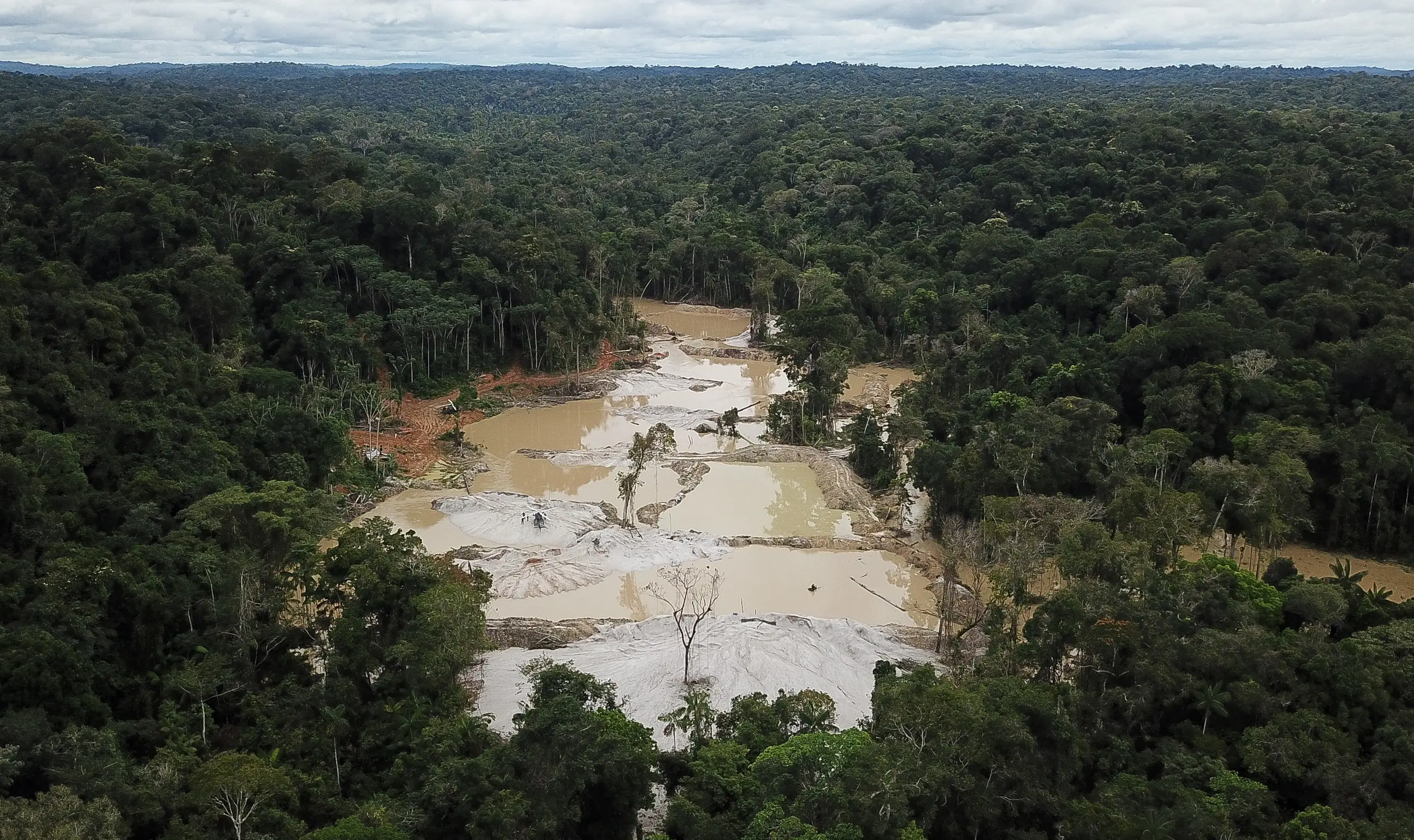
'Our people are dying'
Located between Itaituba and Jacareacanga, the Munduruku Indigenous territory has at least 21 clandestine runways, 19 of which have a deforestation trail within a perimeter of 20 kilometers. Satellite images reveal that no less than 12 of these tracks were built from December 2018, when Jair Bolsonaro was already elected and about to assume the Presidency of the Republic.
Indigenous lands are protected by the Constitution, and any kind of mining activity on them is illegal. Bolsonaro has been striving to change this since February 2020, when he presented PL 191/2020 to the National Congress, which provides for the possibility of exploration on indigenous lands.
With the support of Brasília, illegal mining has advanced. A study by the Socio-Environmental Institute, ISA, points out that between 2019 and 2021, Munduruku land will lose 2,264.8 hectares to illegal mining, an increase of 363 percent compared to previous years. In many of the cases, the interest of the mining sector receives the complacency of the government.
According to the Amazônia Minada project, a map that monitors in real time the mining requirements that affect indigenous lands in Amazônia Legal, there are more than 2.5 thousand mining processes overlapping indigenous territories in the region. Ignoring the Constitution and judicial decisions, the ANM allows these processes to continue.
The main victims are the indigenous people. Indigenous leader Maria Leusa Kaba Munduruku spends most of her time in hiding with her five children and other relatives. She is president of the Munduruku Wakoborũn Indigenous Women's Association, based in Jacareacanga, and had her house burned down by miners.
Without revealing where she lives because of the constant threats, Maria Leusa told me, in August last year, by telephone, how she sees the increasing pressure of gold exploration on indigenous territories in the Tapajós.
"The number of miners in the whole region has increased a lot. They offer 10 percent of the profit, and many indigenous relatives end up accepting the exploitation on their lands. But mining only brings diseases, pollutes our rivers. If we resist, they attack the indigenous communities, like they did with my house," she said.
The Munduruku ethnic group numbers an estimated 14,000 people. The entire indigenous land on which they live is the target of the greed of miners. A video published by the Intercept last December showed the damage done by a mine formed in less than two years in Sai-Cinza.
The leader Alessandra Munduruku, of the Sawré-Muybu indigenous land, which has not yet had its territory ratified, says that the people of the region have started to see small planes more frequently in recent years and is demanding that the federal government act.
"We talked to the relatives and many of them reported that planes are now flying over areas where they didn't fly before. They already know that this means that there is new mining in the region. This is another threat to our people, because just as more fuel and supplies arrive for the miners, weapons and drugs also arrive through these airstrips. The government should prohibit this, but does the opposite," said Alessandra, who also lives under constant threats from the miners.
In the Yanomami indigenous land, in Roraima, Ibama and the Federal Police seized no less than 111 aircraft used to supply illegal mining operations. They used at least 87 clandestine airstrips. A report produced by ISA in partnership with the Hutukara Associação Yanomami points out that mining areas in the region increased 46 percent in 2021 compared to the previous year. The text also cites that 273 indigenous communities in the area have been affected in some way by mining.
The diseases arrive along with the greed for gold. Researchers from the Oswaldo Cruz Foundation, Fiocruz, are conducting studies on the effects of mercury—used to separate gold from clay—on the health of indigenous communities. In Munduruku land, the hair samples of 200 people were analyzed, and almost 60 percent of them showed high levels of contamination. In one village on Sawré-Muybu land, the percentage of those contaminated was close to 90 percent. Mercury causes a variety of effects in contaminated people, from nausea to neurological problems.
"The process of using mercury is rudimentary, because it is illegal, and because of this the waste is greater. It is estimated that for each kilo of gold found, the miner will use three kilos of mercury. That is, two kilos of mercury will be poured into rivers, entering the food chain of fish, the main protein consumed by communities in the region," explained Paulo Basta, coordinator of the Environment, Diversity and Health research group at Fiocruz.
He recalled that all the industrial mercury used in the country is imported, and only reaches the mines due to the lack of government control. "Even if Brazil stops using mercury today in garimpos (mines), this metal will remain in nature for up to 100 years," said Basta.
"Mercury crosses the placental barrier in pregnant women and affects a baby's brain up to seven times more than in an adult. And this has no cure, the child later develops learning problems," warned the researcher.
Nor is it a new problem. In the investigation of the Limão mining operation, a technical report produced in 1984 by Funai already reported on the pressure from miners in the Rio Paru d'Este indigenous land. The document reported that some communities had abandoned their homes in some watersheds because of diseases caused by rivers contaminated with mercury. "The garimpo (mining) will not improve the health of our people. The children get sick, the water is dirty for drinking and the animals are moving away. This year, there was even a case of a Yanomami child who was raped by a miner and ended up dying," said Alessandra Munduruku. "For this government, our life is worth less than ore.”


